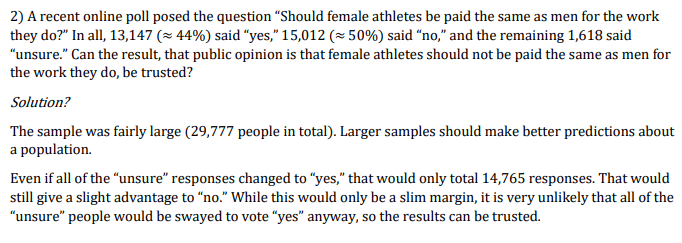2) A recent online poll posed the question "Should female athletes be paid the same as men for the work they do?" In all, 13,147 (× 44%) said "yes," 15,012 (× 50%) said “no," and the remaining 1,618 said "unsure." Can the result, that public opinion is that female athletes should not be paid the same as men for the work they do, be trusted? Solution? The sample was fairly large (29,777 people in total). Larger samples should make better predictions about a population. Even if all of the "unsure" responses changed to "yes," that would only total 14,765 responses. That would still give a slight advantage to "no." While this would only be a slim margin, it is very unlikely that all of the "unsure" people would be swayed to vote "yes" anyway, so the results can be trusted.
2) A recent online poll posed the question "Should female athletes be paid the same as men for the work they do?" In all, 13,147 (× 44%) said "yes," 15,012 (× 50%) said “no," and the remaining 1,618 said "unsure." Can the result, that public opinion is that female athletes should not be paid the same as men for the work they do, be trusted? Solution? The sample was fairly large (29,777 people in total). Larger samples should make better predictions about a population. Even if all of the "unsure" responses changed to "yes," that would only total 14,765 responses. That would still give a slight advantage to "no." While this would only be a slim margin, it is very unlikely that all of the "unsure" people would be swayed to vote "yes" anyway, so the results can be trusted.
Glencoe Algebra 1, Student Edition, 9780079039897, 0079039898, 2018
18th Edition
ISBN:9780079039897
Author:Carter
Publisher:Carter
Chapter10: Statistics
Section10.6: Summarizing Categorical Data
Problem 28PPS
Related questions
Question
Identify whether the solution is correct. Identify the error, if there is one.

Transcribed Image Text:2) A recent online poll posed the question "Should female athletes be paid the same as men for the work
they do?" In all, 13,147 (x 44%) said "yes," 15,012 (= 50%) said “no," and the remaining 1,618 said
"unsure." Can the result, that public opinion is that female athletes should not be paid the same as men for
the work they do, be trusted?
Solution?
The sample was fairly large (29,777 people in total). Larger samples should make better predictions about
a population.
Even if all of the "unsure" responses changed to "yes," that would only total 14,765 responses. That would
still give a slight advantage to “no." While this would only be a slim margin, it is very unlikely that all of the
"unsure" people would be swayed to vote "yes" anyway, so the results can be trusted.
Expert Solution
This question has been solved!
Explore an expertly crafted, step-by-step solution for a thorough understanding of key concepts.
This is a popular solution!
Trending now
This is a popular solution!
Step by step
Solved in 2 steps

Knowledge Booster
Learn more about
Need a deep-dive on the concept behind this application? Look no further. Learn more about this topic, statistics and related others by exploring similar questions and additional content below.Recommended textbooks for you

Glencoe Algebra 1, Student Edition, 9780079039897…
Algebra
ISBN:
9780079039897
Author:
Carter
Publisher:
McGraw Hill

Glencoe Algebra 1, Student Edition, 9780079039897…
Algebra
ISBN:
9780079039897
Author:
Carter
Publisher:
McGraw Hill